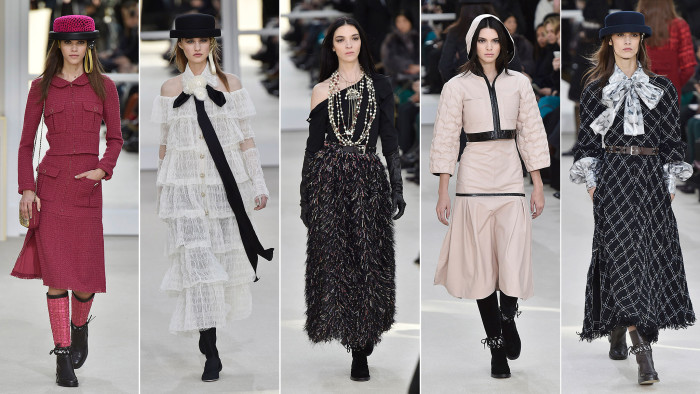Chanel AW16 show report Paris Fashion Week

Roula Khalaf, Editor of the FT, selects her favourite stories in this weekly newsletter.
We live in a cultural landscape so coloured by populism that he who speaks for “the people” clamours louder than considered reason, regardless of what he might say. In the US, the Republican debates have become so soured by point-scoring that discussion of penis size now counts as legitimate political discourse. It’s as depressing as it is dangerous. Everyone needs “followers”, and the fools are rushing in.
In fashion too, the conversation is torn between two camps. In one is the brands that have become obsessed with the consumer, in the wearable wardrobe, in readily available product and high-tech production. “Give them what they want.” Other fashion houses are shrinking away from the mass-produced, retail-based culture, calling on the language of the artisan and the art of slow fashion. At Saint Laurent on Monday, the house presented a debut couture-style show to a tiny number of people behind shuttered doors. At a time when many brands are desperately trying to broaden their reach, the Kering-owned house reverted to an ancient 1970s style of presentation. Ready to buy? Not unless you have Hedi Slimane on speed dial.
What, then, to make of the Chanel prêt-à-porter invitation that announced “front row only” on its hand-drawn cartes? As at Saint Laurent, the set at the Grand Palais was all arranged with row upon row of elegant high-backed chairs, no squashed-up benches here, in a half-mile grid of seating that allowed everyone the best view. Unlike at Saint Laurent, the space accommodated thousands of clients and critics. “Everyone always wants to have a front row seat. And very often they complain that they can’t see the detail. I wanted everyone to be able to see the clothes, and the work that goes into them,” said Karl Lagerfeld backstage.
The atmosphere of exclusivity was a genius stroke, and one of the reasons Chanel remains one of the biggest and most powerful brands around. It has straddled the two camps as neatly as its interlocking Cs. Similarly, the collection entwined both rarified and relatable materials: here a white button-through sweatshirt was thrown around the shoulders of a monochrome zigzag sequin dress; raw-edged denim skirts were worn with traditional Chanel bouclés; a pinky tweed jacket was all finished in a denim trim. Multi-strings of paste pearl baubles spilled around the neck alongside the floatiest and featheriest multi-flecked black skirt; a printed shopper bag emblazoned with images of Lagerfeld’s cat Choupette was paired with silks printed with Coco Chanel’s trophy camelias.

This wasn’t “high-low” fashion, the looks were emphatically bourgeois and expensive; neat skirt lengths skimmed below the knee, cuts were chic, arms were covered, oftentimes in rather wonderful leather gauntlets. For a winter collection it was unusually pink, rosy hued and pretty. Lagerfeld paired each look with a hat: an assembly of flat-top bowlers (a little like Coco Chanel’s own favoured boater but with a much closer, thicker brim) in rose pink leather, denim, tweed and grey. “I wanted to do hats because no one does them anymore,” explained the designer. (Lest we forget, this multibillion-pound fashion house is built on the foundations of a milliner’s shop on rue Cambon.)
Of the details Lagerfeld was so anxious for us to see, there were many: the pencil-case clutches suspended from small fabric-covered bags; a cotton-reel evening bag; the leather chin straps that fastened with a flower clasp; the paper-thin leather skirts in glossy black; a quilted leather in palest blush pink; the “horizontal laces” of an exquisite tiered off-the-shoulder evening dress; or the filmy white dress embroidered with the Chanel logo that followed it; the flat knee boots, severed in two and laced together at the ankle.
There were 93 looks to feast on. No detail overlooked. Chanel populism — with an extra layer of polish.
Comments